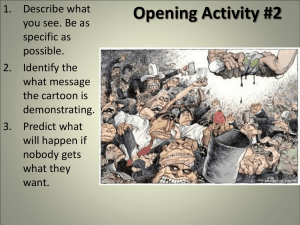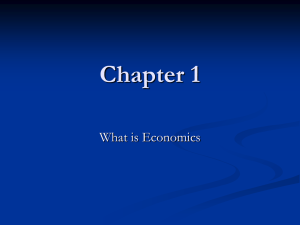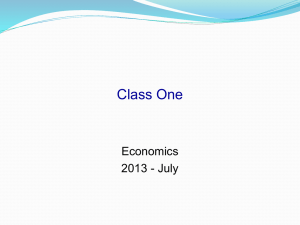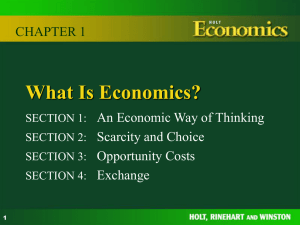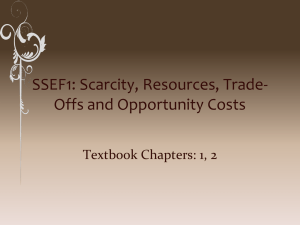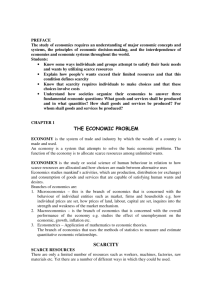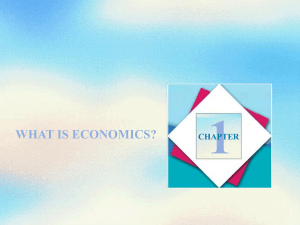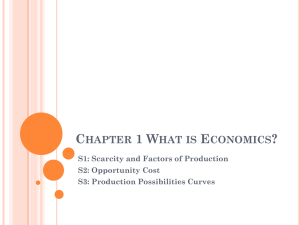Playful Economics Production and Scarcity
advertisement
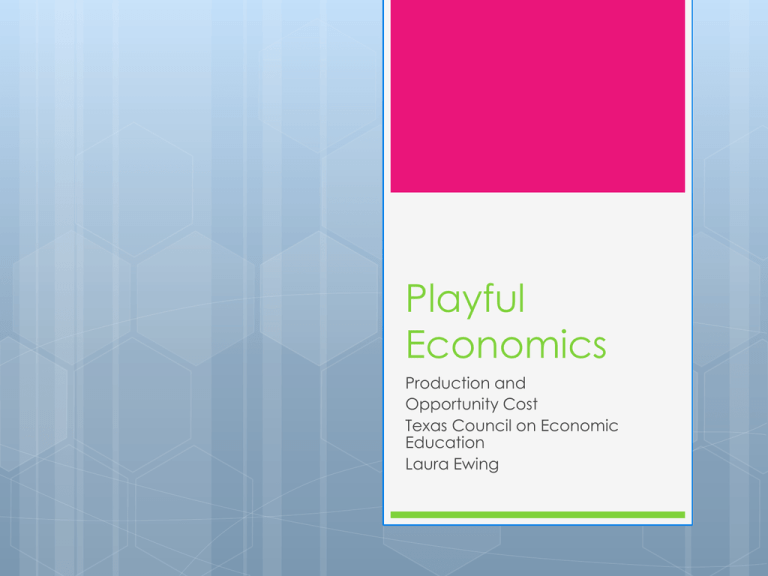
Playful Economics Production and Opportunity Cost Texas Council on Economic Education Laura Ewing Kindergarten Social Studies Economics Strand TEKS (6) Economics. The student understands that basic human needs and wants are met in many ways. The student is expected to: (A) identify basic human needs of food, clothing, and shelter; (B) explain the difference between needs and wants; and First Grade Social Studies Economics Strand TEKS (9) Economics. The student understands the condition of not being able to have all the goods and services one wants. The student is expected to: (A) identify examples of people wanting more than they can have; (B) explain why wanting more than they can have requires that people make choices; and (C) identify examples of choices families make when buying goods and services. Second Grade Social Studies Economics Strand TEKS (9) Economics. The student understands the value of work. The student is expected to: (B) explain the choices people in the U.S. free enterprise system can make about earning, spending, and saving money and where to live and work. Third Grade Social Studies Economics Strand TEKS (7) Economics. The student understands the concept of the free enterprise system. The student is expected to: (A) define and identify examples of scarcity; (B) explain the impact of scarcity on the production, distribution, and consumption of goods and services; and Wish Lists What are your favorite things to buy? What types of things do you like to buy? Why do you want these things? Why do you need these things? Do others like these same things? Scarcity If there is only one toy available and three people want it, what happens? If you owned a store and three people wanted the same toy, what would you do with the price of the product and why? When more people want a product than there are products, that is called scarcity. When you want several things but can only afford to buy one of them, that is scarcity. Scarcity What are some things that are not scarce? In other words, what can you always have? Goods & Services What is the difference? Good: Service: Which of the items on the list are goods and which are services? Rank order: which do you think most important to least important. What Are The Factors of Production? •1. •1. Land •2. Labor •3. Capital •4. Entrepreneurship Can you make some scarce items? Think of some things that are scarce and make them out of modeling clay. Produce a scarcity story by making an example of something people want and then make clay people—all to show scarcity Draw a scarcity situation in the space below. Below your drawing, explain why it is a scarcity situation. 2. Circle the items below that economists would say are not scarce. Shirt Garbage Automobile T.V. Repair Sand in the desert Book Gold Air in the mountains A nurse’s services Bananas Shoes Pencil Air in Space Saltwater at the seashore 3. Draw, label, and color a picture of a good that is very scarce and a good that is not very scarce. 4. In economics, what “clue” tells you if an item is more scarce than another item? Give an example. _________________________________________________________________ _____________ Opportunity Cost What are your two most favorite foods? What does each item cost? What if you only have $ ____ to spend, what would you buy? What is the value of what you gave up? Opportunity Cost What up? was the value of what you gave The value of what you gave up is known as the opportunity cost. Why do we have to make choices? Why can’t we buy everything we want? Opportunity Cost is NOT The sum value of all things given up The good that the students will produce And, one other note: introduction of money will come later. The concept will be taught that one earns money for purchases/consumption from production of goods and services. Classroom Store Would you like to have a classroom store? What kinds of things would you like to buy at the store? How will we get the things to buy at the store? You Are The Producer? What does the word “producer” mean? What does the word “produce” mean? What would you like to produce at the store? How will you produce your good? What are the factors of production? Natural Human Capital Entrepreneurship Get Your Capital And Produce A Quality Product Now, You Are The Consumer What does it mean to be a consumer??? What do consumers do??? How are you able to consume??? Consumers Trade Everyone places their products in the store which is the table in front of the room Who will trade first? Choose one product for which to trade. Consumers Have Opportunity Costs Who will volunteer to trade next? Choose three products in which you are interested. Which What will you choose? is your opportunity cost? Additional Teaching Resources 1. Show and discuss the video, “Opportunity Cost,” from the Econ and Me video series. 2. Use the concept of opportunity cost as much as possible in your classroom. E.g. “If we go to the zoo on our field trip, we can’t go to the Children’s Museum. The visit to the Museum would be our opportunity cost.” 3. Do Lesson 6, Opportunity Cost, in the Herschel’s World of Economics DVD. (See www.kidseconposters.com.) Production What buy? If types of products do you like to you could produce a good or service, what would it be? Why? What are productive resources? Natural or land—resources used in producing goods and services Human capital/labor—human skills gained through education and training Capital—tools services to produce goods and What Are The Productive Resources of Factors of •1. Production? •1. Natural/Land •2. Human capital/Labor •3. Capital •4. Entrepreneurship You produce a product What will you produce? What is the natural part of your product? Who is your human capital? What skills does this person have? What tools will you use? Who is your entrepreneur? Natural Human Capital Resources Resources Resources _____________ _____________ _____________ _____________ _____________ _____________
